Related Research Articles

William the Lion, sometimes styled William I and also known by the nickname Garbh, "the Rough", reigned as King of Scots from 1165 to 1214. His 48-year-long reign was the second longest in Scottish history.

Year 1136 (MCXXXVI) was a leap year starting on Wednesday of the Julian calendar.
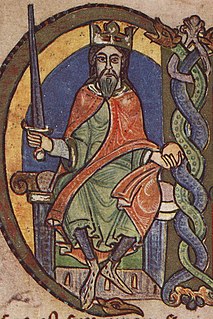
David I or Dauíd mac Maíl Choluim was a 12th-century ruler who was Prince of the Cumbrians from 1113 to 1124 and later King of Scotland from 1124 to 1153. The youngest son of Malcolm III and Margaret of Wessex, David spent most of his childhood in Scotland, but was exiled to England temporarily in 1093. Perhaps after 1100, he became a dependent at the court of King Henry I. There he was influenced by the Anglo-French culture of the court.

The history of the English penny from 1154 to 1485 covers the period of the House of Plantagenet, up to the Battle of Bosworth Field which brought about the beginning of the Tudor period. The Plantagenet period saw an overall rise in quality of the coinage but saw a decline in the number of mints used to produce coins.

The Battle of the Standard, sometimes called the Battle of Northallerton, took place on 22 August 1138 on Cowton Moor near Northallerton in Yorkshire. English forces under William of Aumale repelled a Scottish army led by King David I of Scotland.
Geoffrey Rufus, also called Galfrid Rufus was a medieval Bishop of Durham and Lord Chancellor of England.
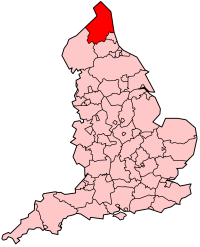
Northumberland, England's northernmost county, is a land where Roman occupiers once guarded a walled frontier, Anglian invaders fought with Celtic natives, and Norman lords built castles to suppress rebellion and defend a contested border with Scotland. The present-day county is a vestige of an independent kingdom that once stretched from Edinburgh to the Humber, hence its name, meaning literally 'north of the Humber'. Reflecting its tumultuous past, Northumberland has more castles than any other county in England, and the greatest number of recognised battle sites. Once an economically important region that supplied much of the coal that powered the industrial revolution, Northumberland is now a primarily rural county with a small and gradually shrinking population.

Ranulf II, 4th Earl of Chester (1099–1153), was an Anglo-Norman baron who inherited the honour of the palatine county of Chester upon the death of his father Ranulf le Meschin, 3rd Earl of Chester. He was descended from the Counts of Bessin in Normandy.
The Bishop of Carlisle is the Ordinary of the Church of England Diocese of Carlisle in the Province of York.
This timeline summarises significant events in the history of Northumbria and Northumberland.
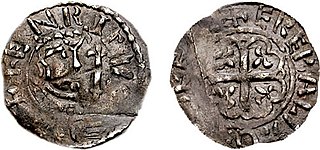
Henry of Scotland was heir apparent to the Kingdom of Alba. He was also the 3rd Earl of Northumbria and the 3rd Earl of Huntingdon. He was the son of King David I of Scotland and Queen Maud, 2nd Countess of Huntingdon.
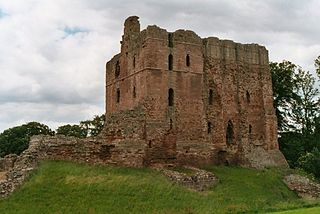
Norham Castle is a castle in Northumberland, England, overlooking the River Tweed, on the border between England and Scotland. It is a Grade I listed building and a Scheduled Ancient Monument. The castle saw much action during the wars between England and Scotland.

The relationship between the Kingdom of England and King David I, who was King of Scotland between 1124 and 1153, was partly shaped by David's relationship with the particular King of England, and partly by David's own ambition. David had a good relationship with and was an ally of Henry I of England, the King who was largely responsible for David's early career. After Henry's death, David upheld his support for his niece, the former Empress-consort, Matilda, and expanded his power in northern England in the process, despite his defeat at the Battle of the Standard in 1138.
The second treaty of Durham was a peace treaty concluded between kings Stephen of England and David I of Scotland, on 9 April 1139.
The Battle of Alnwick (1174) is one of two battles fought near the town of Alnwick, in Northumberland, England. In the battle, which took place on 13 July 1174, William I of Scotland, also known as William the Lion, was captured by a small English force led by Ranulf de Glanvill.
Events from the 1130s in England.
Eustace fitz John, Constable of Chester, was a powerful magnate in northern England during the reigns of Henry I, Stephen and Henry II. From a relatively humble background in South East England, Eustace made his career serving Henry I, and was elevated by the king through marriage and office into one of the most important figures in the north of England. Eustace acquired a great deal of property in the region, controlled Bamburgh Castle, and served jointly with Walter Espec as justiciar of the North.
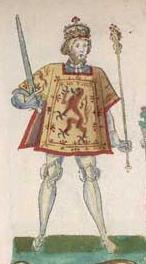
The Treaty of York (1464) was made between England and Scotland on 1 June 1464 at York and was intended to establish 15 years of peace. Previously Scotland had supported the defeated House of Lancaster in the English civil War of the Roses.

Wark on Tweed Castle, sometimes referred to as Carham Castle, is a ruined motte-and-bailey castle at the West end of Wark on Tweed in Northumberland. The ruins are a Grade II* listed building.

The Siege of Wark is a 1138 siege of Wark on Tweed Castle conducted from May–November by Scottish forces under David I against the defending English garrison. The siege was part of a campaign launched by David in support of his niece, the Empress Matilda, and her claim to the English throne over that of Stephen of Blois who had seized the throne in 1135. The invasion followed a similar campaign in 1136 when David had succeeded in gaining control of Cumberland, and raids launched in 1137 and earlier in 1138.
References
- ↑ Williams, Hywel (2005). Cassell's Chronology of World History . Weidenfeld & Nicolson. ISBN 0-304-35730-8.
- ↑ "Doncaster 'is part of Scotland' after 900-year-old administrative error comes to light". Yahoo News UK & Ireland. 27 February 2012. Retrieved 18 September 2014.